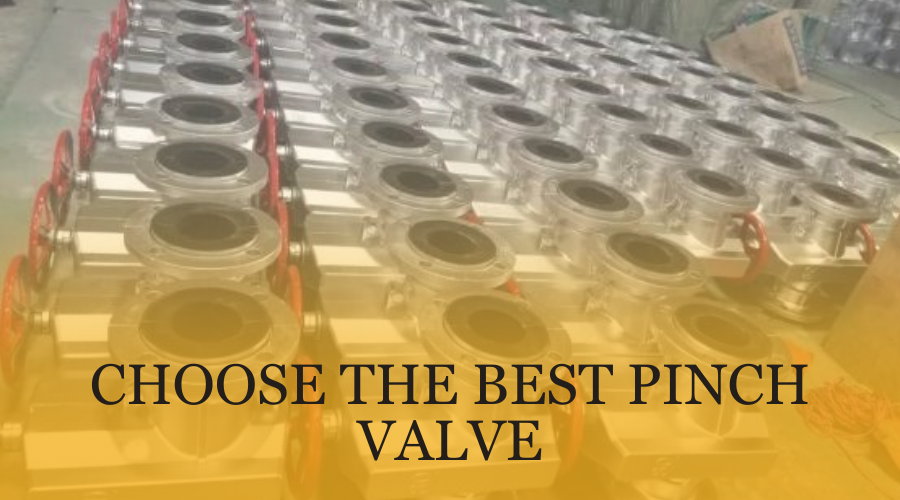

The industrial market tends to select pinch valves as their primary solution for controlling the flow of fluids along with powders and slurries. The basic construction of pinch valves delivers effortless flow management alongside low maintenance needs combined with excellent durability. Your selection of the best pinch valve for your application needs serious examination of multiple important elements.
Industries rely on two main types of pinch valves: internal and external forces. All are primarily beneficial when used to analyze for the desired outcome. An external pinching device, such as a plunger, pinches a flow route element, which functions as the pinch valve's primary operating mechanism. However, industries have two pinch valves: a solenoid type and a manual hand-actuated kind that works like a clamp.
Although internal pinch valves are sealed and require no care, external pinch valves include tubing that can be readily replaced. Certain criteria must be met when choosing which valves to purchase for usage in scientific or medical equipment. Examining the material, maintenance, cycle life, carryover volume, and internal volume is crucial. Some of these factors have been given below:
The internal volume of flow path components is one of the most common design factors used in medical and scientific applications. Instrument designers are critical to minimizing the use of expensive reagents, small patient numbers, and liquid loss during medical operations.
The volume of pinch valves' external and internal style depends on the tubes' diameter and length. In the case of pinch valve tubing, the identification usually reflects the capacity flow necessary for a specific usage. Most medical and scientific users opt for tubing with an inside diameter of 1. Or 5 mm or less, or a flow rate of less than 50 mL min. If the internal volume is a concern, then the total flow restriction of the valve should be chosen so that it offers very little headroom to the pressure drop requirement.
The carryover volume is the precise volume of fluid that remains in the valve after it changes states. Usually, this wouldn't be a massive concern for a 2-way "on-off" pinch valve, but in the case of a 3-way pinch valve, the fluid within mixes with other fluids and goes down the drain after cleaning. Therefore, reducing this volume is very important. This internal pinch valve is favorable when the carryover volume is a significant concern since its carryover volume between the pinch point and the Y-shaped combination point is relatively small.
When designing a medical or scientific instrument, it is critical to consider the amount of effort and cost needed to maintain the instrument. When these factors are a prime concern, the internal pinch valve is thus deemed the most suitable. Typically, these valves are meant to last at least 5 million rotations before requiring replacement. On the other hand, the external pinch valves might demand a change in the tubings to approximately 200,000 to 500,000 cycles. In contrast, the solenoid actuators have almost the same lifespan as the internal pinch valves.
To understand the disparity between internal and external pinch valve tubing life, one must consider the characteristics of common tubing types. For example, inexpensive silicone and flexible PVC tubing, typically utilized in external pinch valves, quickly degrades and is usually replaced with frequency. Intern pinch valve materials like the elastomeric tubing EPDM or the fluoroelastomer FKM currently come with life ratings that are at least an order of magnitude better for a slightly higher initial cost.
This shows that cycle life, depending on the material used, is essential in determining which pinch valve to use on a particular application. External pinch valves must, therefore, be applied where flow paths have to be replaced, especially in applications related to medical practices in living organisms. For instance, in dialysis machines, the tubing through which blood is transported to remove waste products is often changed to avoid cross-infection. An internal pinch valve without periodic lubrication is best suited for in-vitro diagnostic systems where the cleaning solution can be passed between samples.
One crucial factor to consider when choosing pinch valves is the type of material used in the flow area. External pinch valves can differ substantially in terms of the type; the reason for tubing selection is compatibility with biological fluids and organic solvents. For this reason, it is crucial to perform tests for each application. It is essential to identify the tubing connectors and also qualify them individually.
Internal pinch valves with tubing connectors, such as hose barbs or threaded fittings, involve more than one wetted material. Because these materials are much harder to fine-tune, they are chosen for versatility in terms of the applications they can be used with. Consequently, corresponding incompatibilities are the exception.
Choosing an internal or external pinch valve for use in such processes as analytical chemistry, diagnostics, medical equipment, or next-generation sequencing is critical. Overall, internal pinch valves are the most suitable when the internal volume is low, the carryover volume is as low as possible, and the service life is long. External pinch valves are ideal for applications that change the tubing due to their attributes. Each type of valve has a relatively low internal volume, smooth internal passage, and compatibility with most fluids in the health and research sectors.
In hydraulic transmission in industrial, automotive, and hydraulic uses, hydra...
READ FULLManufacturers produce diverse item ranges through rubber molding, including es...
READ FULLRubber molding is a standard way to give rubber shape in the industry. At rubb...
READ FULL